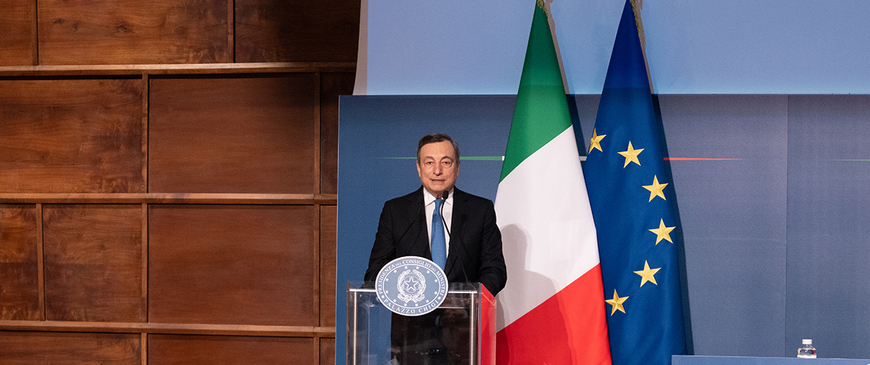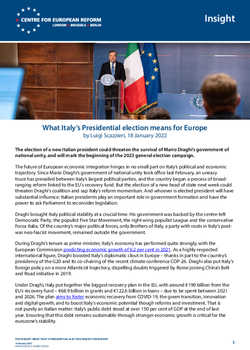
What Italy's Presidential election means for Europe
The election of a new Italian president could threaten the survival of Mario Draghi’s government of national unity, and will mark the beginning of the 2023 general election campaign.
The future of European economic integration hinges in no small part on Italy’s political and economic trajectory. Since Mario Draghi’s government of national unity took office last February, an uneasy truce has prevailed between Italy’s largest political parties, and the country began a process of broad-ranging reform linked to the EU’s recovery fund. But the election of a new head of state next week could threaten Draghi’s coalition and sap Italy’s reform momentum. And whoever is elected president will have substantial influence: Italian presidents play an important role in government formation and have the power to ask Parliament to reconsider legislation.
The election of a new head of state next week could threaten Draghi’s coalition and sap Italy’s reform momentum.
Draghi brought Italy political stability at a crucial time. His government was backed by the centre-left Democratic Party, the populist Five Star Movement, the right-wing populist League and the conservative Forza Italia. Of the country’s major political forces, only Brothers of Italy, a party with roots in Italy’s post-war neo-fascist movement, remained outside the government.
During Draghi’s tenure as prime minister, Italy’s economy has performed quite strongly, with the European Commission predicting economic growth of 6.2 per cent in 2021. As a highly respected international figure, Draghi boosted Italy’s diplomatic clout in Europe – thanks in part to the country’s presidency of the G20 and its co-chairing of the recent climate conference COP-26. Draghi also put Italy’s foreign policy on a more Atlanticist trajectory, dispelling doubts triggered by Rome joining China’s Belt and Road initiative in 2019.
Under Draghi, Italy put together the biggest recovery plan in the EU, with around €190 billion from the EU’s recovery fund – €68.9 billion in grants and €122.6 billion in loans – due to be spent between 2021 and 2026. The plan aims to foster economic recovery from COVID-19, the green transition, innovation and digital growth, and to boost Italy’s economic potential though reforms and investment. That is not purely an Italian matter: Italy’s public debt stood at over 150 per cent of GDP at the end of last year. Ensuring that this debt remains sustainable through stronger economic growth is critical for the eurozone’s stability.
The recovery plan funding is divided into 11 tranches, the first of which, worth €25 billion, was paid out in August. To receive each of the next ten instalments, Italy needs to achieve pre-agreed milestones, such as passing specific legislation. Without reaching these milestones, funding can be delayed or reduced. Draghi’s government started with some of the most impactful and urgently needed reforms: it passed laws to begin the process of restructuring the justice system, the public procurement system and the civil service. At the end of December, Italy said it had fulfilled all conditions to receive the next instalment from the recovery fund, worth €21 billion, and it sent the Commission a request for the funds.
Despite this strong start, however, much remains to be done to ensure a robust economic recovery and foster lasting growth. Reforms of the notoriously slow justice system and of the civil service will need to be fully implemented via additional legislation. Such measures will take years and therefore require long-term political commitment. If implementation falters, Italy risks missing out on future tranches from the EU’s recovery fund, and the fund itself risks becoming discredited. Since the fund was, in part, set up to strengthen Italy’s economy, its success or failure could determine the fate of future fiscal integration in Europe.
The future of Italy’s reform trajectory will depend in part on the outcome of the presidential election. Votes are cast by members of both houses of Parliament and by regional representatives. The winning candidate for president requires two-thirds of the votes, but if no candidate reaches this threshold, an absolute majority is enough from the fourth round of voting. Formally there are no candidates – although controversial former prime minister Silvio Berlusconi is openly pursuing a bid to become president.
One scenario is that MPs of the governing parties elect Draghi, who has suggested that he is ready to take on the role. As president, Draghi would act as a kind of guarantor of Italy’s reform path: he would continue to provide reassurance to international investors and European partners that Italy will fully implement its commitments and that the money from the recovery fund will continue to be spent well. While Draghi’s formal powers would be limited, he would provide stability and could potentially steer a future populist or anti-EU government away from highly damaging choices.
As president, Draghi would act as a kind of guarantor of Italy’s reform path.
Draghi’s problem is that his election could destabilise the government; under a different prime minister, such as current economics minister Daniele Franco, the coalition of national unity might not survive. Matteo Salvini, the leader of the League, has a strong incentive to go into opposition before the June 2023 general election, because remaining in government reduces his ability to criticise it on COVID-19 restrictions, migration policy or failing to tackle the rising cost of living. According to polls, the League has lost substantial support since it joined Draghi’s government, mainly to the benefit of Brothers of Italy. This threatens Salvini’s position as the leader of the largest party of the Italian right.
Many on the right of Italian politics say they would prefer Berlusconi to become president. But if he was chosen, Italy’s international credibility would suffer and there would be no impartial guarantor of reforms. Another possibility is that MPs settle on a less controversial consensus candidate, or even try to give the incumbent president, Sergio Mattarella, a second term. While this was the scenario that played out with former President Giorgio Napolitano’s exceptional re-election in 2013, Mattarella has made it clear that this option should be a last resort.
If Draghi is not elected president, he would probably remain as prime minister. In theory, this would give him more time in an executive role to lead the implementation of the recovery fund and to ensure that reforms progress further. However, Draghi may not be as effective for the remaining part of his mandate as he has been so far. Infighting amongst the coalition parties would almost inevitably grow as the 2023 election drew closer, and the League would probably end up quitting the government well before the election.
Even if the League went into opposition, the government would probably have enough support to survive. Following a referendum in 2020, the next parliament will have fewer MPs. Many know they will not be re-elected and are keen to complete a full term. This is especially true of Five Star MPs, because the party is polling a lot worse than it did at the last election. However, the League’s departure from government would revive doubts amongst international investors about Italy’s long-term political stability and commitment to reform. This would probably translate into higher interest rates for Italian government bonds, especially as the European Central Bank is set to slow down its bond purchases. And a government that is domestically weak would have a lower standing in the EU, with other member-states less likely to involve it in consultations over efforts to change the Union’s fiscal rules, for example.
Ultimately, the future of the reform efforts that Draghi has initiated will depend on the results of the 2023 election. Broadly, two outcomes are possible: a centre-left coalition made up of the Democratic party and the Five Star Movement, or a right-wing coalition consisting of the League and Brothers of Italy, and probably Forza Italia.
Ultimately, the future of the reform efforts that Draghi has initiated will depend on the results of the 2023 election.
A centre-left coalition would represent the strongest possible guarantee that the implementation of reforms would continue. Depending on the positions of the governments in Berlin and Paris, Rome could weigh in on EU reform debates in areas such as climate change and upholding the rule of law in Poland and Hungary. Changing the EU’s fiscal rules to allow for more public investment would remain possible, although any changes would not be as sweeping as Italy would like them to be.
Investors and European partners would be more worried by a right-wing government. Many supporters of the League and Brothers of Italy are eurosceptic, with a recent poll for Italy’s Istituto Affari Internazionali suggesting that around half of them would vote to leave the EU in a hypothetical referendum on membership. But leaving the EU or the euro is not something that either party is currently advocating: both say they favour European co-operation in many areas, although they want to re-assert the primacy of the nation state vis-à-vis supranational institutions.
In practice, a right-wing government would have strong incentives to stick to previous commitments, because it would not want to lose the recovery fund money. But the pace of implementing reform could slow, and changes to the EU’s fiscal rules would be more challenging, since European partners would have little trust in political parties that have strongly criticised the EU and the euro’s fiscal framework. The momentum to make the recovery fund permanent would wane.
In foreign policy, a right-wing coalition would be sceptical of actions that it thinks would lead to more tensions with Russia, but would favour a tougher policy towards China. There would probably be substantial friction with other member-states on changing the EU’s migration rules, and it would be harder for the EU to make progress on its climate package and to force unruly governments to respect the rule of law.
If Rome is able to maintain its recent reform momentum, Italy’s economy will be strengthened, its debt will become more sustainable and the euro’s foundations will become more robust. European partners would be more likely to see the recovery fund as a success story, and the case for changing EU fiscal rules and for more joint investment would be strengthened. Conversely, if Rome fails to implement reforms, this would spell trouble for Italy, with questions about the sustainability of its debt quickly re-emerging. Faltering reforms in Italy would also put the eurozone on a more fragile footing, and probably kill off the idea of further joint EU borrowing for the foreseeable future.
Luigi Scazzieri is a senior research fellow at the Centre for European Reform.


Add new comment